Guernsey Tramways
History
After several abortive railway and tramway schemes in Guernsey, Henry Brady, a London-based promoter and engineer, successfully secured a concession — from the 'States of Deliberation' of Guernsey — to build a circa 2.8-mile tramway between the harbours at St Peter Port and St Sampson. Approval was granted on the 2nd May 1877, with construction commencing the following year in February 1878. Although the promoter was authorised to use horse traction, the intention was always to use steam traction, though this would be subject to inspection and approval of the type of engine to be used.
All was, however, not well, the contractor soon stopping work, probably because there were issues with his payment. Having failed locally, Brady now attempted to raise money by registering (on the 29th May 1878), a new company — the Guernsey Steam Tramway Company — that would hopefully finance, build and operate the tramway; the new company was, however, based in London, which would be a source of much friction over the coming years.
A new contractor was appointed on the 9th July 1878, the first rails being laid on the 1st August. A specimen Merryweather steam-tram engine was procured, which was successfully demonstrated to the authorities, following which two new Merryweathers were obtained in time for the opening, which took place on the 6th June 1879. Unfortunately, the tramway company was financially handicapped from the outset, a situation from which it never really recovered. There certainly seems to have been a suspicion of financial impropriety, as the contractor, who was appointed by Brady, was handsomely paid for his efforts, the tramway costing much more than equivalent mainland tramways, despite the fact that for 40% of its length, it ran on the road side, which ought to have made it considerably cheaper to construct. The tramway was initially worked by the contractor under a lease arrangement, but the tensions with the company (arising from the construction costs) soon led to the latter taking over itself, in June 1880.
The standard-gauge tramway ran northwards from a terminus near the Albert Statue in St Peter Port along the coast to the vicinity of the Grand Bouet, where it left the road, running to its seaward side. After crossing over to the landward side of the road, the line continued northwards parallel to Bulwer Road before resuming street running just south of South Quay, which it followed westwards to a terminus in St Sampson's Bridge. Unusually for a tramway in the British Isles, the engines pulled multiple trailers, some photographs showing up to three being towed.
The two engines, which were somewhat underpowered for the line, were simply insufficient (at least in number) to run an adequate service, and though they were joined by a third in December 1879, this was from an untested manufacturer, who was presumably selected on cost grounds; this proved to be a poor choice, as the engine was mechanically unreliable, being stored out of use by 1883.
The company struggled on with its inadequate motive power until 1882, when it found enough money to acquire four second-hand Henry Hughes engines from the Falcon Works, which are believed to have been leased; the engines entered service between October 1882 and August 1883. This proved, however, to be yet another poor decision, the mechanical reliability of these engines being far from satisfactory.
By 1888, the GSTCo was on its last legs, with a new company — the Guernsey Railway Company — being registered on the 18th September to acquire the assets of the old company. On the 8th November, the GSTCo shareholders voted to wind the company up and to appoint a liquidator, the last tram running on the 5th January 1889.
The GRCo duly purchased the assets of the GSTCo, the transfer being registered with the Royal Court of Guernsey on the 8th August 1889. The tramway was re-opened on the 2nd December 1889 using the original Merryweather engines, which had been overhauled, along with yet another second-hand engine, this time an elderly R&W Hawthorn product, which arrived the following year. Although this may seem like history repeating itself, the GRCo had very good reasons for buying an old second-hand engine, as its eyes were firmly set on converting the tramway to overhead electric traction.
Permission to convert the tramway was obtained from the 'States' on the 29th January 1891, the new overhead electric tramway opening almost one year later on the 19th February 1892. The tramway, which was the first overhead electric tramway in the British Isles, was built and equipped by Siemens Brothers and Company Limited, to whom operation was leased for one year, giving them time (and the responsibility) to iron out the issues that would inevitably occur with the new technology. Issues there certainly were, as the steam trams were often called upon to maintain a service, the last of them only going for scrap in 1898. The GRCo presumably took over operation of the tramway on or around the 4th April 1893.
The initial electric services were delivered by five tramcars, which were joined by two more in May 1893. These were followed by a mixture of steam-trailer rebuilds, and new and secondhand purchases, the electric fleet reaching its maximum size of 19 vehicles by 1905, most of them running right up until the demise of the tramway in 1934.
The GRCo, which was adequately capitalised, also bought out the local horse-bus competition — the Guernsey Omnibus Company — on the 1st May 1895, a year during which it also commenced upgrading all its electric tramcars to more modern specifications.
The tramway now settled down to a profitable existence, the only event of note being the outbreak of the Great War, which would see a loss of men (and their skills) to the armed forces, and the employment of conductresses and eventually motorwomen, to replace them. Maintenance inevitably suffered, not just due to the shortage of skills, but also the impossibility of sourcing spares and new materials.
The company was able to pay dividends of around 5% right through to 1921, when they rose to 7.5%, before falling slightly, to 6.25% in 1922, and back to 5% in 1923. By the following year, however, the tramway was suffering from competition from independent motorbus operators, which led to a significant decline in the number of the passengers, and for the first time, an operating loss, though the company as a whole stayed in the black due to profits from its motorbus operations, as well as other non-tramway activities.
The tramway was now in terminal decline, recording loss after loss until 1933, when the situation became critical due to the company's disastrous foray into ship ownership and repair. There was now little option other than to close the loss-making tramway, services being reduced on the 1st October 1933 such that only two tramcars were required to operate them, followed 8 months later by closure, the last tram of all running on the 9th June 1934.
Uniforms
As with most steam tramway concerns, the Guernsey Steam Tramway Company issued its drivers with railway-footplate type clothing (e.g., heavy cotton jackets and trousers, usually light in colour), along with cotton or flat caps. Conductors wore informal but smart attire: jackets, shirts and ties, along with the fashionable headgear of the day, which in Guernsey's case seems to have been a little more idiosyncratic than was perhaps the case on the mainland. No change appears to have been made in this policy following the Guernsey Railway Company takeover of 1889.
Electric services were introduced in 1892, and were initially operated by Siemens Brothers and Company Limited, with the GRCo only taking over in the spring 1893. It is probable that staff working these services wore informal attire, surviving records clearly state that staff were first issued with uniforms in 1897. These were of blue serge with yellow or red piping, and probably comprised single-breasted jackets with lapels, which were worn along with soft-topped, peaked caps; it is unclear whether the jackets or the caps carried insignia.
In the mid-to-late Edwardian era, staff were issued with double-breasted, lancer-style tunics with five pairs of buttons (narrowing from top to bottom) and with stand-up collars; the latter bore an employee number on the left-hand side and individual 'G R' initials on the right-hand side in metal letters/numerals. The soft-topped peaked caps were superseded by tensioned-crown peaked caps, which bore script-lettering grade badges, either 'Motorman' or 'Conductor'. It is currently unclear whether the badges and buttons were brass or nickel. By the time of the Great War, photographs suggest that a switch had been made to single-breasted jackets with five buttons, two breast pockets (with button closures), and stand-up collars; all insignia being as previously carried.
Towards the end of the system's life, the company appears to have adopted a policy of 'anything will do', as numerous photographs show staff wearing uniforms without badges, and conductors wearing informal attire with whatever cap was to hand, including motormen's caps.
Only one photograph appears to have survived depicting an inspector (from the late-Edwardian or early George V era), and this indicates that they wore typical senior staff tramway uniforms comprising single-breasted jackets with hidden buttons (or more likely a hook and eye affair), edged in material of a finer quality than the main jacket. The jackets had stand-up collars that bore the grade 'Inspector' in embroidered script lettering. Caps were the same style as those worn by tramcar staff, but bore a script lettering 'Inspector' badge, almost certainly embroidered on a hat band.
In common with many tramway systems, Guernsey employed female staff during the Great War to replace men lost to the armed services; these ladies were issued with tailored double-breasted jackets with five pairs of closely spaced buttons. The jackets had two hip-level flap pockets and lapels, and were worn with long matching skirts; the jacket collars bore insignia of some description, probably identical to that carried on the mens collars. Caps appear to have been identical to those issued to the men, and with the same badges.
Further reading
For a detailed history, see 'Guernsey's Trams' by John Carman; self-published (2011).
Images
Steam tram drivers and conductors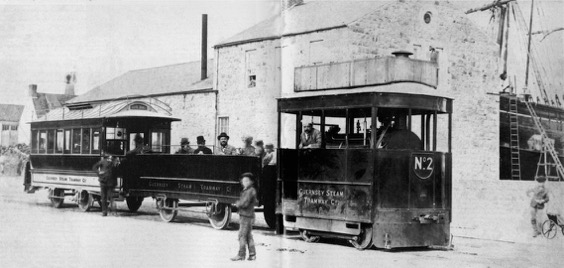
Guernsey Steam Tramway Company No 2, a Merryweather product, along with a Starbuck open-topped trailer (either No 5 or 6) and a Starbuck enclosed trailer (probably No 1) — photo undated, but as the middle vehicle was rebuilt in the first year of operation, it must have been taken in 1879. Photo courtesy of the Tramways and Light Railway Society, with thanks to David Voice.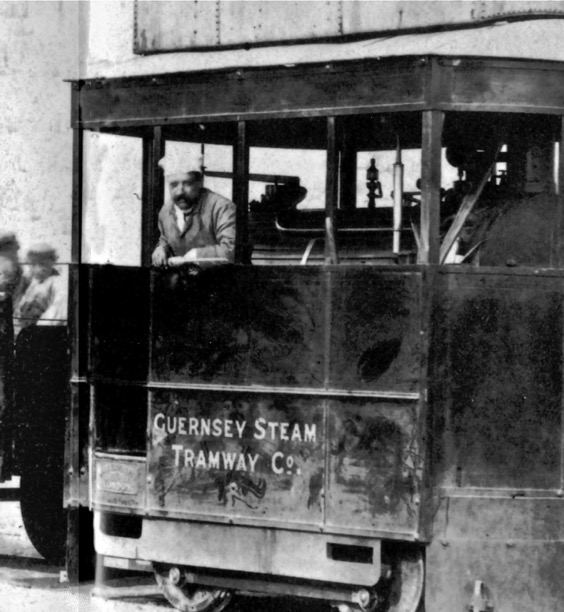
An enlargement of the above photograph showing the driver, who is wearing typical railway footplate attire, along with something akin to a baker's or matelot's hat, though this may simply be a trick of the camera angle.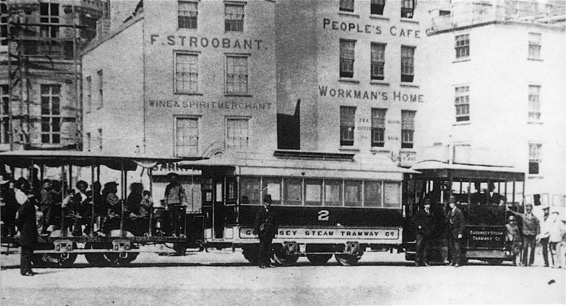
Merryweather steam tram (No 1 or No 2) and Starbuck-built trailers No 2 (middle), and either No 3 or No 4 (left) — photo purportedly taken on the opening day, 6th June 1879. Photo courtesy of the Tramways and Light Railway Society, with thanks to David Voice.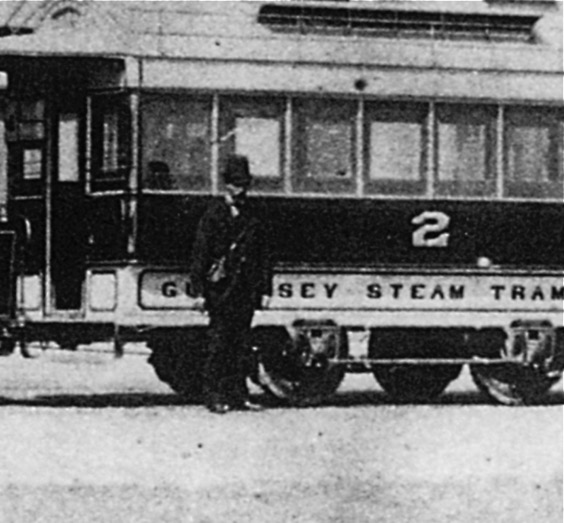
An enlargement of the above photograph showing the conductor, who is clearly wearing informal attire, topped off by a tall hat that seems distinctly old fashioned, even for this early date.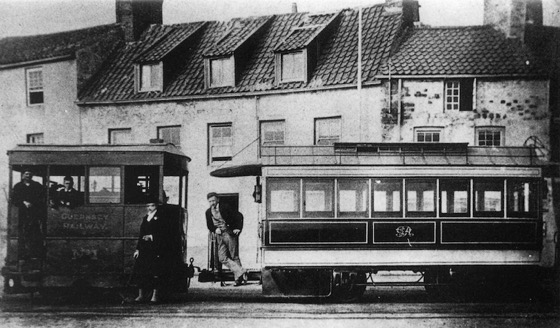
Steam Tram No 1 and Trailer No 2 at Salerie in Guernsey Railway Company days — photo undated, but probably taken in the early 1890s. Photo courtesy of the Tramways and Light Railway Society, with thanks to David Voice.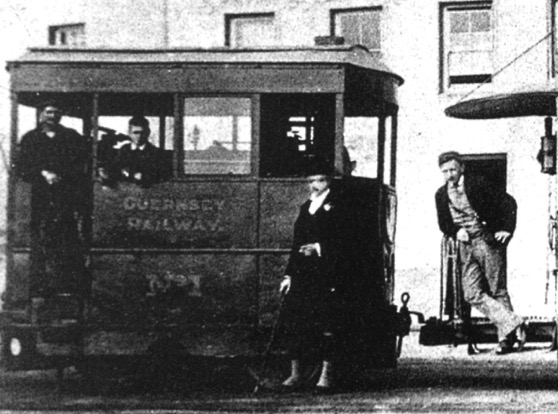
An enlargement of the above photograph showing the footplate crew and the conductor, the latter leaning nonchalantly on the platform railings and clearly wearing informal attire.
Motormen and conductors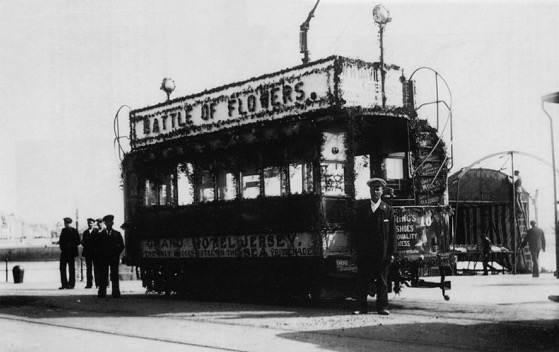
Guernsey Railway Company Tram No 10 — photo undated, but probably taken around the turn of the century. Photo courtesy of the Tramways and Light Railway Society, with thanks to David Voice.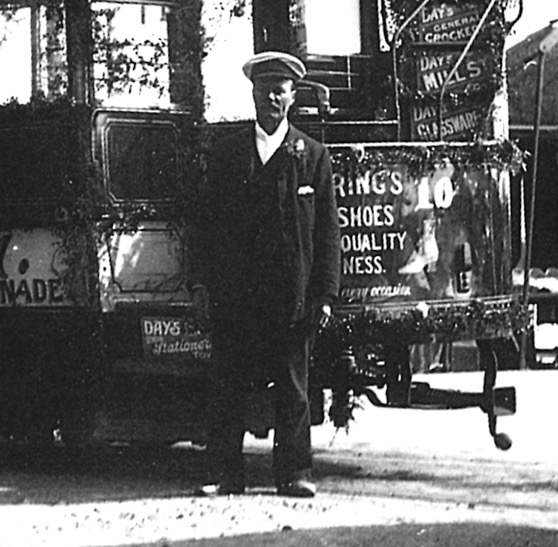
An enlargement of the above photograph, showing one of the tramcar staff in the type of uniform worn between 1897 and the mid-Edwardian era.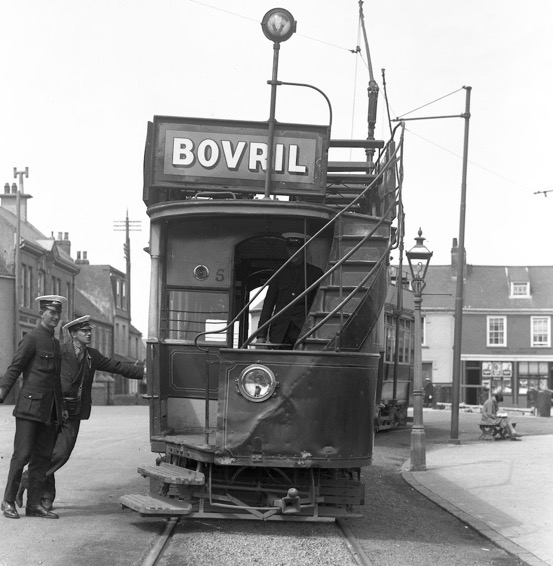
Two conductors and a motorman pose with a very battered looking Tramcar No 5 at Post Office Corner, St Sampson's Bridge on the 23rd July 1929. Photo by Dr H Nicol, courtesy of the National Tramway Museum. 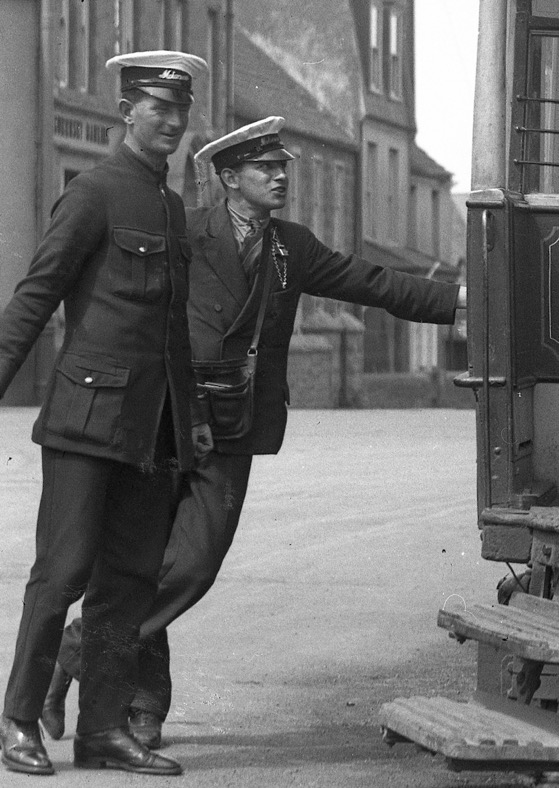
An enlargement of the above photograph showing one of the motormen (presumably in charge of the tramcar behind No 5) and a conductor. Uniform policy was seemingly a little lacks by this time, as the conductor appears to be wearing informal attire, including a rather snazzy shirt and tie, along with a motorman's cap!
General pattern script-lettering cap badges — 'Motorman' and 'Conductor' — of the type used by the Guernsey Railway Company from around the mid-Edwardian era onwards. It is currently unknown whether the badges were brass or nickel.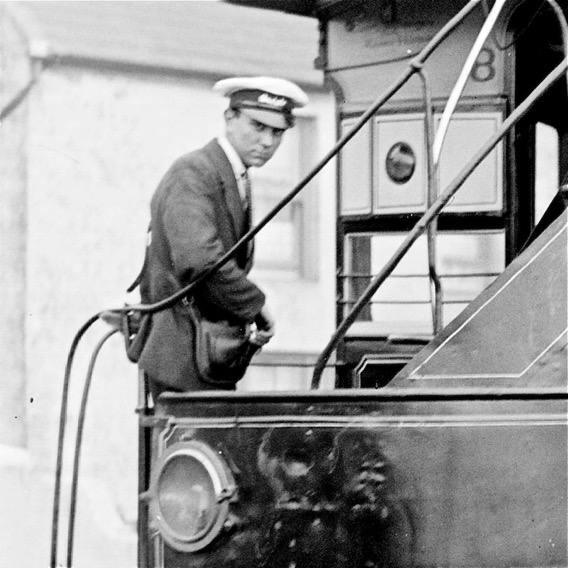
Another shot taken in 1929 by Dr H Nicol, this time of the conductor of Tramcar No 8 at the passing loop outside the Red Lion. Apart from his cap, the individual depicted appears to be wearing informal attire. Photo by Dr H Nicol, courtesy of the National Tramway Museum.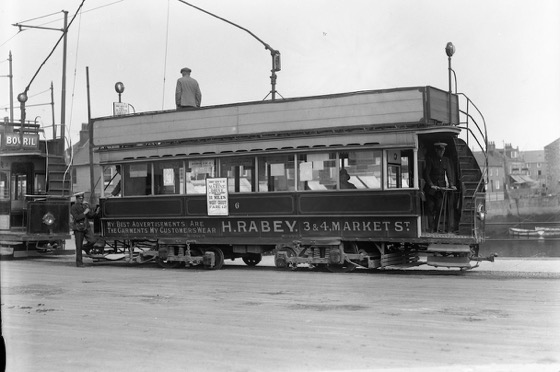
Tramcar No 6 and crew at St Sampson's Harbour on 23rd July 1929. Photo by Dr H Nicol, courtesy of the National Tramway Museum.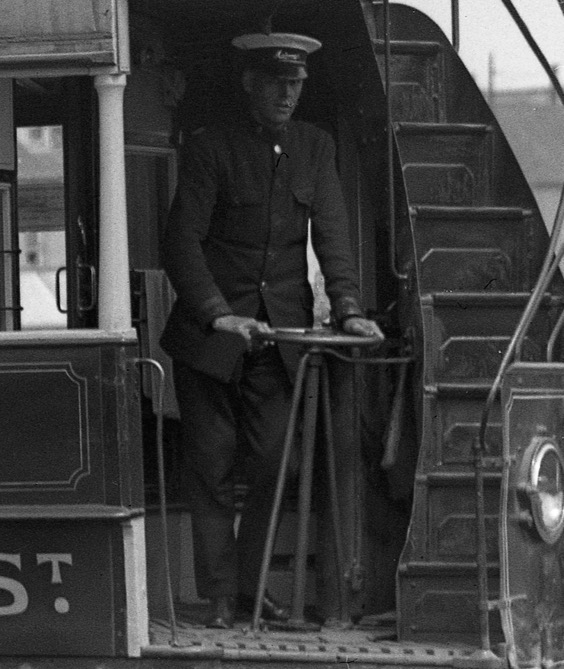
An enlargement of the above photograph showing the motorman, who appears, unlike the previous photos, to have collar designations.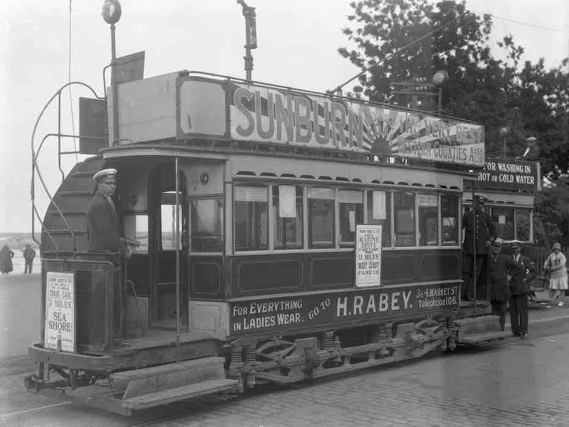
Tramcar No 7 and another unidentified tram, along with their respective crews, waiting at the St Peter Port terminus. Photo undated, but probably taken in 1929 by Dr H Nicol, courtesy of the National Tramway Museum.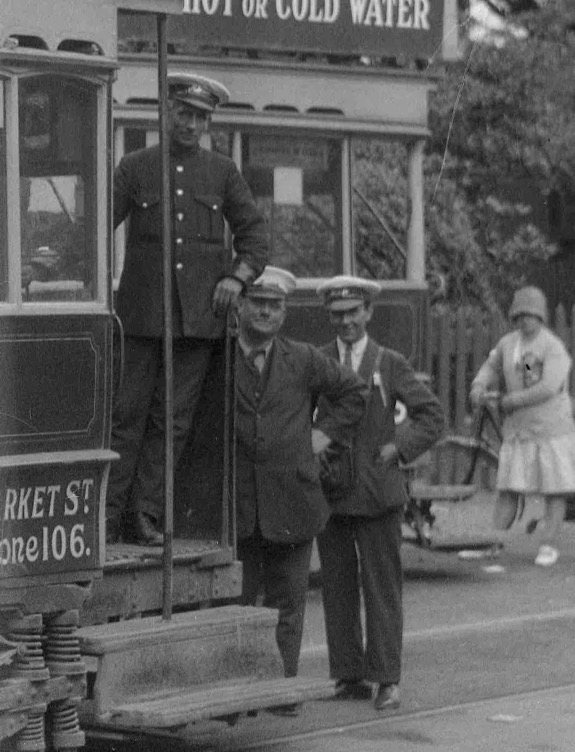
An enlargement of the above photograph showing the motormen and one of the conductors, two of whom are wearing informal attire, apart from their caps.